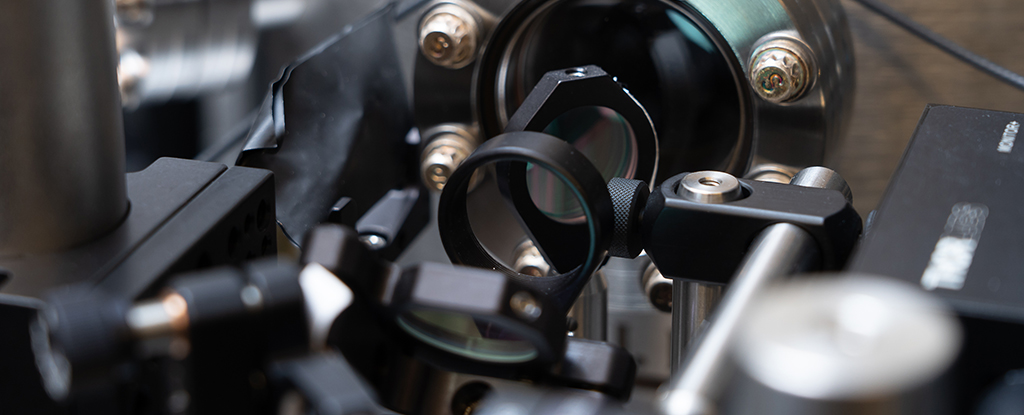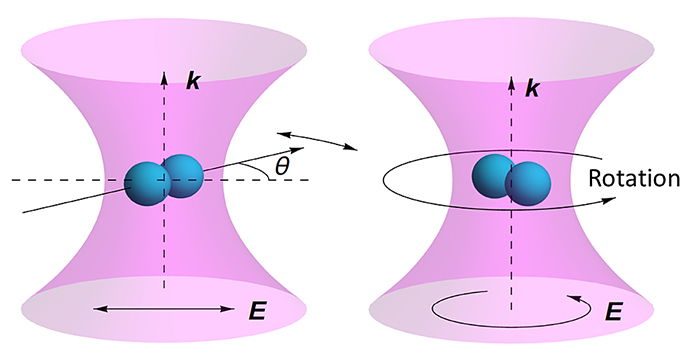Skip to comments.
This Is The Fastest Rotor Humans Have Ever Built, And It's Bending Our Understanding of Physics
Science Alert ^
| 24 JUL 2018
| DAVID NIELD
Posted on 07/26/2018 11:43:06 AM PDT by Heartlander
This Is The Fastest Rotor Humans Have Ever Built, And It's Bending Our Understanding of Physics
Mind-boggling.
Scientists have created a tiny rotor that rotates at speeds of up to 60 billion revolutions a minute – the fastest-spinning human-made rotor in history, and 100,000 times faster than your average dental drill.
The record-breaking invention not only pushes the boundaries of physics but could also be used to study some of the mysteries of quantum mechanics, and how objects operate in a vacuum.
We're actually dealing with some of the fundamentals of science here, like how gravity and friction work in a vacuum. Now that the nano-rotor is up and running, some detailed investigations can begin, according to the team of researchers.
"This study has many applications, including material science," says senior researcher Tongcang Li from Purdue University in Indiana. "We can study the extreme conditions different materials can survive in."
The super-spinner is made up of a silica nanoparticle, shaped like a dumbbell and levitated in a vacuum using a laser. The laser can be polarised in a straight line or in a circle, and its the circular mode that produces the rotations.
When the laser is straight, the dumbbell vibrates rather than rotating – which means it can consequently be used to measure very weak forces. Both modes of operation are going to be useful for future research.
The nanoparticle itself is only about the size of a bacterial particle, around 170 nanometres wide and 320 nanometres long, so you can't see it with the naked eye. But this is what the setup looks like:
 (Purdue University photo/Vincent Walter)
(Purdue University photo/Vincent Walter)
"People say that there is nothing in vacuum, but in physics, we know it's not really empty," says Li.
"There are a lot of virtual particles which may stay for a short time and then disappear. We want to figure out what's really going on there, and that's why we want to make the most sensitive torsion balance."
 Vibrate and spin modes. (Purdue University photo/Tongcang Li)
Vibrate and spin modes. (Purdue University photo/Tongcang Li)
One of the advantages of getting a nanoparticle suspended and rotating in a vacuum like this is that very precise measurements can be made, unaffected by the standard variations in air flow and temperature.
And this team isn't the only one busy working on getting nanoparticles rotating in a vacuum: the potential discoveries further down the line are substantial.
As for quantum mechanics, it helps scientists explain the behaviour of the Universe at the very small and the really big scales – areas where the classical physics model as we know it starts to fall down.
Having such a tiny object to experiment on should give is a better understanding at how the building blocks of matter work at the tiniest scales.
In other words, you might be hearing a lot more about this nanoscale rotor in the future.
The research has been published in Physical Review Letters
TOPICS: Education; Science
KEYWORDS:
Navigation: use the links below to view more comments.
first previous 1-20, 21-40, 41-60, 61-80, 81-82 next last
To: Artemis Webb
21
posted on
07/26/2018 12:05:40 PM PDT
by
Big Red Badger
(UNSCANABLE in an IDIOCRACY)
To: Heartlander
Boy, what’s the torque like on that baby?
22
posted on
07/26/2018 12:06:32 PM PDT
by
Fido969
(In!)
To: 2ndDivisionVet
"100 years from now 2018 will look like 1492." Not if Liberals have their way!
23
posted on
07/26/2018 12:06:36 PM PDT
by
Redleg Duke
(The Democrats in California want another civil war over cheap labor!)
To: fishtank
NASA heck, think what this will do for NASCAR.
24
posted on
07/26/2018 12:08:04 PM PDT
by
Lurkina.n.Learnin
(Wisdom and education are different things. Don't confuse them.)
To: Waverunner
60 billion revolutions a minute Sounds like an Ocasio-Cortez campaign slogan.
25
posted on
07/26/2018 12:08:20 PM PDT
by
PGR88
To: rjsimmon
Interesting point.
It’s a vacuum. Can’t you just apply acceleration to it and multiply by the amount of time applied to get velocity at the instant the acceleration is removed? It’s going to be a linear function, if I recall my physics.
Kinda like pushing on a merry go round that’s frictionless. As long as you can apply force, the merry go round accelerates?
I’ll just wait for the schooling now . . .
To: Redleg Duke
Well then get everyone you know who’s conservative to vote this November!
27
posted on
07/26/2018 12:12:06 PM PDT
by
2ndDivisionVet
(You cannot invade the mainland US. There'd be a rifle behind every blade of grass.)
To: Heartlander
My God, this spins faster than a member of Congress on a controversial subject!
28
posted on
07/26/2018 12:15:07 PM PDT
by
PTBAA
To: PGR88
29
posted on
07/26/2018 12:19:05 PM PDT
by
762X51
To: rightwingcrazy
If a pair of virtual particles come into existence and the rotor whacks one of them and then gets out of the way before it can interact with the other one, can we get an effect like Hawking radiation?
30
posted on
07/26/2018 12:20:06 PM PDT
by
snarkpup
("The rules don't matter when you're infected with political rabies." - The People's Cube)
To: Heartlander
31
posted on
07/26/2018 12:21:40 PM PDT
by
Moonman62
(Give a man a fish and he'll be a Democrat. Teach a man to fish and he'll be a responsible citizen.)
To: DannyTN
Yeah but the alternative is not to explore particle physics. And that’s where I think the real scientific breakthroughs in many fields is going to come from.Indeed. There is so much we don't know yet and will, hopefully in our lifetimes. Not just in mechanics but in medicine too. We're made of atomic particles after all. Once we can manipulate them, immortality may not be out of reach :-).
To: Heartlander
The rpm has to be theoretical. No way they could measure it.
33
posted on
07/26/2018 12:22:17 PM PDT
by
raybbr
(That progressive bumper sticker on your car might just as wll say, "Yes, I'm THAT stupid!")
To: Heartlander
"Scientists have created a tiny rotor that rotates at speeds of up to 60 billion revolutions a minute – the fastest-spinning human-made rotor in history, and 100,000 times faster than your average dental drill. "
Fast-spinning neutron star smashes speed limit
By Maggie McKee
January 12, 2006
The fastest-spinning neutron star ever found has been discovered in a crowded star cluster near the centre of the Milky Way, a new study reveals.
The star rotates 716 times per second [2,577,600 per min] – faster than some theories predict is possible – and therefore may force researchers to revise their models.
Neutron stars form when a massive star explodes at the end of its life and leaves behind a super-dense, spinning ball of neutrons. These stellar corpses emit intense beams of radio waves from their poles and are called pulsars.
Most pulsars rotate just a few times per second, but some spin hundreds of times faster. These so-called millisecond pulsars whip around so quickly because they are thought to have stripped mass – and angular momentum – from companion stars at some point in their histories.
Astronomers led by Jason Hessels of McGill University in Montreal, Canada, used the 100-metre Green Bank Telescope in West Virginia, US, to clock the newly discovered pulsar at 716 rotations per second, or 716 hertz. The previous record holder, which spins at 642 Hz, was discovered in 1982. ...”
https://www.newscientist.com/article/dn8576-fast-spinning-neutron-star-smashes-speed-limit/
34
posted on
07/26/2018 12:23:20 PM PDT
by
ETL
(Obama-Hillary, REAL Russia collusion! Uranium-One Deal, Missile Defense, Iran Deal, Nukes: Click ETL)
To: Heartlander
60 billion RPM’s. How do you measure that?
35
posted on
07/26/2018 12:24:22 PM PDT
by
ImJustAnotherOkie
(All I know is what I read in the papers.)
To: Heartlander
I’ve often contemplated that as we look out into the vastness of space and are amazed by discoveries, similar amazing discoveries await to be found in the opposite direction in minutia of which our exploration has just dented the surface.
36
posted on
07/26/2018 12:25:49 PM PDT
by
Rebelbase
( Tagline disabled.)
To: Waverunner
I thought dem brains were spinning this fast about 20 months ago. YEah ... and they're even smaller than this object.
37
posted on
07/26/2018 12:26:16 PM PDT
by
NorthMountain
(... the right of the people to keep and bear arms shall not be infringed)
To: snarkpup
“If a pair of virtual particles come into existence and the rotor whacks one of them and then gets out of the way before it can interact with the other one, can we get an effect like Hawking radiation?”
What are the odds of that happening?
To: Heartlander
It is wonderful when hearty souls, toiling in the fields of theoretical and practical physics, grasp a handle that pulls the curtain back on the mysteries of our universe through dedicated effort and perseverance.
or
a flea circus....
(the PHD need beer money)
Either way, should be fun!
KYPD
39
posted on
07/26/2018 12:27:33 PM PDT
by
petro45acp
(So why wasn't anyone there willing, able, and equipped to protect those people?)
To: rjsimmon
They did not mention how the rotations were counted. If it is based upon the pulse rate of the laser while circular, it would seem that the rotation is limited to the lasers ability to pulse. The speed of light? Interesting. In a suspended vacuum, assuming the particle can maintain its integrity, if the pulse stop penetrating the spinning "device", have we not accelerated an object to the speed of light? WHOA!
What prevents the particle from spinning faster than light, besides light itself? Theoretically, if the device is spinning at the speed of light and then launched in space, is there not a component of the device (the outer edge) that will exceed the speed limit?
Physics is fun. ;o)
Navigation: use the links below to view more comments.
first previous 1-20, 21-40, 41-60, 61-80, 81-82 next last
Disclaimer:
Opinions posted on Free Republic are those of the individual
posters and do not necessarily represent the opinion of Free Republic or its
management. All materials posted herein are protected by copyright law and the
exemption for fair use of copyrighted works.
FreeRepublic.com is powered by software copyright 2000-2008 John Robinson
 (Purdue University photo/Vincent Walter)
(Purdue University photo/Vincent Walter) Vibrate and spin modes. (Purdue University photo/Tongcang Li)
Vibrate and spin modes. (Purdue University photo/Tongcang Li)